Flood
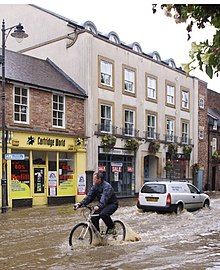
A flood is an overflow of water (or rarely other fluids) that submerges land that is usually dry.[1] In the sense of "flowing water", the word may also be applied to the inflow of the tide. Floods are of significant concern in agriculture, civil engineering and public health. Human changes to the environment often increase the intensity and frequency of flooding. Examples for human changes are land use changes such as deforestation and removal of wetlands, changes in waterway course or flood controls such as with levees. Global environmental issues also influence causes of floods, namely climate change which causes an intensification of the water cycle and sea level rise.[2]: 1517 For example, climate change makes extreme weather events more frequent and stronger.[3] This leads to more intense floods and increased flood risk.[4][5]
Natural types of floods include river flooding, groundwater flooding coastal flooding and urban flooding sometimes known as flash flooding. Tidal flooding may include elements of both river and coastal flooding processes in estuary areas. There is also the intentional flooding of land that would otherwise remain dry. This may take place for agricultural, military, or river-management purposes. For example, agricultural flooding may occur in preparing paddy fields for the growing of semi-aquatic rice in many countries.
Flooding may occur as an overflow of water from water bodies, such as a river, lake, sea or ocean. In these cases, the water overtops or breaks levees, resulting in some of that water escaping its usual boundaries.[6] Flooding may also occur due to an accumulation of rainwater on saturated ground. This is called an areal flood. The size of a lake or other body of water naturally varies with seasonal changes in precipitation and snow melt. Those changes in size are however not considered a flood unless they flood property or drown domestic animals.
Floods can also occur in rivers when the flow rate exceeds the capacity of the river channel, particularly at bends or meanders in the waterway. Floods often cause damage to homes and businesses if these buildings are in the natural flood plains of rivers. People could avoid riverine flood damage by moving away from rivers. However, people in many countries have traditionally lived and worked by rivers because the land is usually flat and fertile. Also, the rivers provide easy travel and access to commerce and industry.
Flooding can damage property and also lead to secondary impacts. These include in the short term an increased spread of waterborne diseases and vector-bourne disesases, for example those diseases transmitted by mosquitos. Flooding can also lead to long-term displacement of residents.[7] Floods are an area of study of hydrology and hydraulic engineering.
A large amount of the world's population lives in close proximity to major coastlines,[8] while many major cities and agricultural areas are located near floodplains.[9] There is significant risk for increased coastal and fluvial flooding due to changing climatic conditions.[10]
Types
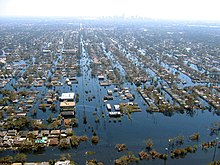



Areal flooding

Floods can happen on flat or low-lying areas when water is supplied by rainfall or snowmelt more rapidly than it can either infiltrate or run off. The excess accumulates in place, sometimes to hazardous depths. Surface soil can become saturated, which effectively stops infiltration, where the water table is shallow, such as a floodplain, or from intense rain from one or a series of storms. Infiltration also is slow to negligible through frozen ground, rock, concrete, paving, or roofs. Areal flooding begins in flat areas like floodplains and in local depressions not connected to a stream channel, because the velocity of overland flow depends on the surface slope. Endorheic basins may experience areal flooding during periods when precipitation exceeds evaporation.[11]
River flooding
Floods occur in all types of river and stream channels, from the smallest ephemeral streams in humid zones to normally-dry channels in arid climates to the world's largest rivers. When overland flow occurs on tilled fields, it can result in a muddy flood where sediments are picked up by run off and carried as suspended matter or bed load. Localized flooding may be caused or exacerbated by drainage obstructions such as landslides, ice, debris, or beaver dams.
Slow-rising floods most commonly occur in large rivers with large catchment areas. The increase in flow may be the result of sustained rainfall, rapid snow melt, monsoons, or tropical cyclones. However, large rivers may have rapid flooding events in areas with dry climates, since they may have large basins but small river channels, and rainfall can be very intense in smaller areas of those basins.
In extremely flat areas, such as the Red River Valley of the North in Minnesota, North Dakota, and Manitoba, a type of hybrid river/areal flooding can occur, known locally as "overland flooding". This is different from "overland flow" defined as "surface runoff". The Red River Valley is a former glacial lakebed, created by Lake Agassiz, and over a length of 550 mi (890 km), the river course drops only 236 ft (72 m), for an average slope of about 5 inches per mile (or 8.2 cm per kilometer).[12] In this very large area, spring snowmelt happens at different rates in different places, and if winter snowfall was heavy, a fast snowmelt can push water out of the banks of a tributary river so that it moves overland, to a point further downstream in the river or completely to another streambed. Overland flooding can be devastating because it is unpredictable, it can occur very suddenly with surprising speed, and in such flat land it can run for miles. It is these qualities that set it apart from simple "overland flow".
Rapid flooding events, including flash floods, more often occur on smaller rivers, rivers with steep valleys, rivers that flow for much of their length over impermeable terrain, or normally-dry channels. The cause may be localized convective precipitation (intense thunderstorms) or sudden release from an upstream impoundment created behind a dam, landslide, or glacier. In one instance, a flash flood killed eight people enjoying the water on a Sunday afternoon at a popular waterfall in a narrow canyon.[citation needed] Without any observed rainfall, the flow rate increased from about 50 to 1,500 cubic feet per second (1.4 to 42 m3/s) in just one minute.[13] Two larger floods occurred at the same site within a week, but no one was at the waterfall on those days. The deadly flood resulted from a thunderstorm over part of the drainage basin, where steep, bare rock slopes are common and the thin soil was already saturated.
Flash floods are the most common flood type in normally-dry channels in arid zones, known as arroyos in the southwest United States and many other names elsewhere. In that setting, the first flood water to arrive is depleted as it wets the sandy stream bed. The leading edge of the flood thus advances more slowly than later and higher flows. As a result, the rising limb of the hydrograph becomes ever quicker as the flood moves downstream, until the flow rate is so great that the depletion by wetting soil becomes insignificant.
Coastal flooding
Coastal areas may be flooded by storm surges combining with high tides and large wave events at sea, resulting in waves over-topping flood defenses or in severe cases by tsunami or tropical cyclones. A storm surge, from either a tropical cyclone or an extratropical cyclone, falls within this category. A storm surge is "an additional rise of water generated by a storm, over and above the predicted astronomical tides".[14] Due to the effects of climate change (e.g. sea level rise and an increase in extreme weather events) and an increase in the population living in coastal areas, the damage caused by coastal flood events has intensified and more people are being affected.[15]
Flooding in estuaries is commonly caused by a combination of storm surges caused by winds and low barometric pressure and large waves meeting high upstream river flows.
Urban flooding

Intentional floods
The intentional flooding of land that would otherwise remain dry may take place for agricultural, military or river-management purposes. This is a form of hydraulic engineering. Agricultural flooding may occur in preparing paddy fields for the growing of semi-aquatic rice in many countries.

Flooding for river management may occur in the form of diverting flood waters in a river at flood stage upstream from areas that are considered more valuable than the areas that are sacrificed in this way. This may be done ad hoc,[17] or permanently, as in the so-called overlaten (literally "let-overs"), an intentionally lowered segment in Dutch riparian levees, like the Beerse Overlaat in the left levee of the Meuse between the villages of Gassel and Linden, North Brabant.
Military inundation creates an obstacle in the field that is intended to impede the movement of the enemy.[18] This may be done both for offensive and defensive purposes. Furthermore, in so far as the methods used are a form of hydraulic engineering, it may be useful to differentiate between controlled inundations and uncontrolled ones. Examples for controlled inundations include those in the Netherlands under the Dutch Republic and its successor states in that area[19][20] and exemplified in the two Hollandic Water Lines, the Stelling van Amsterdam, the Frisian Water Line, the IJssel Line, the Peel-Raam Line, and the Grebbe line in that country.
To count as controlled, a military inundation has to take the interests of the civilian population into account, by allowing them a timely evacuation, by making the inundation reversible, and by making an attempt to minimize the adverse ecological impact of the inundation. That impact may also be adverse in a hydrogeological sense if the inundation lasts a long time.[21]
Examples for uncontrolled inundations are the second Siege of Leiden[22] during the first part of the Eighty Years' War, the flooding of the Yser plain during the First World War,[23] and the Inundation of Walcheren, and the Inundation of the Wieringermeer during the Second World War).
Causes

Floods are caused by many factors or a combination of any of these generally prolonged heavy rainfall (locally concentrated or throughout a catchment area), highly accelerated snowmelt, severe winds over water, unusual high tides, tsunamis, or failure of dams, levees, retention ponds, or other structures that retained the water. Flooding can be exacerbated by increased amounts of impervious surface or by other natural hazards such as wildfires, which reduce the supply of vegetation that can absorb rainfall.
During times of rain, some of the water is retained in ponds or soil, some is absorbed by grass and vegetation, some evaporates, and the rest travels over the land as surface runoff. Floods occur when ponds, lakes, riverbeds, soil, and vegetation cannot absorb all the water.
This has been exacerbated by human activities such as draining wetlands that naturally store large amounts of water and building paved surfaces that do not absorb any water.[24] Water then runs off the land in quantities that cannot be carried within stream channels or retained in natural ponds, lakes, and human-made reservoirs. About 30 percent of all precipitation becomes runoff[25] and that amount might be increased by water from melting snow.
Upslope factors

River flooding is often caused by heavy rain, sometimes increased by melting snow. A flood that rises rapidly, with little or no warning, is called a flash flood. Flash floods usually result from intense rainfall over a relatively small area, or if the area was already saturated from previous precipitation.
The amount, location, and timing of water reaching a drainage channel from natural precipitation and controlled or uncontrolled reservoir releases determines the flow at downstream locations. Some precipitation evaporates, some slowly percolates through soil, some may be temporarily sequestered as snow or ice, and some may produce rapid runoff from surfaces including rock, pavement, roofs, and saturated or frozen ground. The fraction of incident precipitation promptly reaching a drainage channel has been observed from nil for light rain on dry, level ground to as high as 170 percent for warm rain on accumulated snow.[26]
Most precipitation records are based on a measured depth of water received within a fixed time interval. Frequency of a precipitation threshold of interest may be determined from the number of measurements exceeding that threshold value within the total time period for which observations are available. Individual data points are converted to intensity by dividing each measured depth by the period of time between observations. This intensity will be less than the actual peak intensity if the duration of the rainfall event was less than the fixed time interval for which measurements are reported. Convective precipitation events (thunderstorms) tend to produce shorter duration storm events than orographic precipitation. Duration, intensity, and frequency of rainfall events are important to flood prediction. Short duration precipitation is more significant to flooding within small drainage basins.[27]
The most important upslope factor in determining flood magnitude is the land area of the watershed upstream of the area of interest. Rainfall intensity is the second most important factor for watersheds of less than approximately 30 square miles or 80 square kilometres. The main channel slope is the second most important factor for larger watersheds. Channel slope and rainfall intensity become the third most important factors for small and large watersheds, respectively.[28]
Time of Concentration is the time required for runoff from the most distant point of the upstream drainage area to reach the point of the drainage channel controlling flooding of the area of interest. The time of concentration defines the critical duration of peak rainfall for the area of interest.[29] The critical duration of intense rainfall might be only a few minutes for roof and parking lot drainage structures, while cumulative rainfall over several days would be critical for river basins.
Downslope factors
Water flowing downhill ultimately encounters downstream conditions slowing movement. The final limitation in coastal flooding lands is often the ocean or some coastal flooding bars which form natural lakes. In flooding low lands, elevation changes such as tidal fluctuations are significant determinants of coastal and estuarine flooding. Less predictable events like tsunamis and storm surges may also cause elevation changes in large bodies of water. Elevation of flowing water is controlled by the geometry of the flow channel and, especially, by depth of channel, speed of flow and amount of sediments in it[28] Flow channel restrictions like bridges and canyons tend to control water elevation above the restriction. The actual control point for any given reach of the drainage may change with changing water elevation, so a closer point may control for lower water levels until a more distant point controls at higher water levels.
Effective flood channel geometry may be changed by growth of vegetation, accumulation of ice or debris, or construction of bridges, buildings, or levees within the flood channel.
Periodic floods occur on many rivers, forming a surrounding region known as the flood plain. Even when rainfall is relatively light, the shorelines of lakes and bays can be flooded by severe winds—such as during hurricanes—that blow water into the shore areas.
Climate change
Coincidence
Extreme flood events often result from coincidence such as unusually intense, warm rainfall melting heavy snow pack, producing channel obstructions from floating ice, and releasing small impoundments like beaver dams.[33] Coincident events may cause extensive flooding to be more frequent than anticipated from simplistic statistical prediction models considering only precipitation runoff flowing within unobstructed drainage channels.[34] Debris modification of channel geometry is common when heavy flows move uprooted woody vegetation and flood-damaged structures and vehicles, including boats and railway equipment. Recent field measurements during the 2010–11 Queensland floods showed that any criterion solely based upon the flow velocity, water depth or specific momentum cannot account for the hazards caused by velocity and water depth fluctuations.[35] These considerations ignore further the risks associated with large debris entrained by the flow motion.[36]
Negative impacts
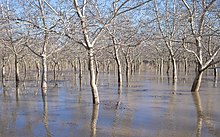
Floods can be a huge destructive power. When water flows, it has the ability to demolish all kinds of buildings and objects, such as bridges, structures, houses, trees, and cars. Economical, social and natural environmental damages are common factors that are impacted by flooding events and the impacts that flooding has on these areas can be catastrophic.[37]
Impacts on infrastructure and societies
There have been numerous flood incidents around the world which have caused devastating damage to infrastructure, the natural environment and human life.[37]
Floods can have devastating impacts to human societies. Flooding events worldwide are increasing in frequency and severity, leading to increasing costs to societies.[37]
Catastrophic riverine flooding can result from major infrastructure failures, often the collapse of a dam. It can also be caused by drainage channel modification from a landslide, earthquake or volcanic eruption. Examples include outburst floods and lahars. Tsunamis can cause catastrophic coastal flooding, most commonly resulting from undersea earthquakes.
Economic impacts
The primary effects of flooding include loss of life and damage to buildings and other structures, including bridges, sewerage systems, roadways, and canals. The economic impacts caused by flooding can be severe.[9]
Every year flooding causes countries billions of dollars worth of damage that threatens the livelihood of individuals.[38] As a result, there is also significant socio-economic threats to vulnerable populations around the world from flooding.[38] For example, in Bangladesh in 2007, a flood was responsible for the destruction of more than one million houses. And yearly in the United States, floods cause over $7 billion in damage.[39]
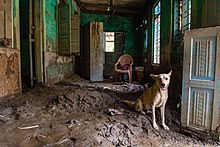
Flood waters typically inundate farm land, making the land unworkable and preventing crops from being planted or harvested, which can lead to shortages of food both for humans and farm animals. Entire harvests for a country can be lost in extreme flood circumstances. Some tree species may not survive prolonged flooding of their root systems.[40]
Flooding in areas where people live also has significant economic implications for affected neighborhoods. In the United States, industry experts estimate that wet basements can lower property values by 10–25 percent and are cited among the top reasons for not purchasing a home.[41] According to the U.S. Federal Emergency Management Agency (FEMA), almost 40 percent of small businesses never reopen their doors following a flooding disaster.[42] In the United States, insurance is available against flood damage to both homes and businesses.[43]
Economic hardship due to a temporary decline in tourism, rebuilding costs, or food shortages leading to price increases is a common after-effect of severe flooding. The impact on those affected may cause psychological damage to those affected, in particular where deaths, serious injuries and loss of property occur.
Health impacts

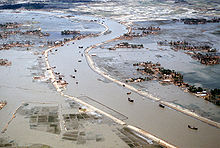
Fatalities connected directly to floods are usually caused by drowning; the waters in a flood are very deep and have strong currents.[44] Deaths do not just occur from drowning, deaths are connected with dehydration, heat stroke, heart attack and any other illness that needs medical supplies that cannot be delivered.[44]
Injuries can lead to an excessive amount of morbidity when a flood occurs. Injuries are not isolated to just those who were directly in the flood, rescue teams and even people delivering supplies can sustain an injury. Injuries can occur anytime during the flood process; before, during and after.[44] During floods accidents occur with falling debris or any of the many fast moving objects in the water. After the flood rescue attempts are where large numbers injuries can occur.[44]
Communicable diseases are increased due to many pathogens and bacteria that are being transported by the water.There are many waterborne diseases such as cholera, hepatitis A, hepatitis E and diarrheal diseases, to mention a few. Gastrointestinal disease and diarrheal diseases are very common due to a lack of clean water during a flood. Most of clean water supplies are contaminated when flooding occurs. Hepatitis A and E are common because of the lack of sanitation in the water and in living quarters depending on where the flood is and how prepared the community is for a flood.[44]
When floods hit, people lose nearly all their crops, livestock, and food reserves and face starvation.[45]
Floods also frequently damage power transmission and sometimes power generation, which then has knock-on effects caused by the loss of power. This includes loss of drinking water treatment and water supply, which may result in loss of drinking water or severe water contamination. It may also cause the loss of sewage disposal facilities. Lack of clean water combined with human sewage in the flood waters raises the risk of waterborne diseases, which can include typhoid, giardia, cryptosporidium, cholera and many other diseases depending upon the location of the flood.
Damage to roads and transport infrastructure may make it difficult to mobilize aid to those affected or to provide emergency health treatment.
Flooding can cause chronically wet houses, leading to the growth of indoor mold and resulting in adverse health effects, particularly respiratory symptoms.[46] Respiratory diseases are a common after the disaster has occurred. This depends on the amount of water damage and mold that grows after an incident. Research suggests that there will be an increase of 30–50% in adverse respiratory health outcomes caused by dampness and mold exposure for those living in coastal and wetland areas. Fungal contamination in homes is associated with increased allergic rhinitis and asthma.[47] Vector borne diseases increase as well due to the increase in still water after the floods have settled. The diseases that are vector borne are malaria, dengue, West Nile, and yellow fever.[44] Floods have a huge impact on victims' psychosocial integrity. People suffer from a wide variety of losses and stress. One of the most treated illness in long-term health problems are depression caused by the flood and all the tragedy that flows with one.[44]
Loss of life
Below is a list of the deadliest floods worldwide, showing events with death tolls at or above 100,000 individuals.
| Death toll | Event | Location | Year |
|---|---|---|---|
| 2,500,000–3,700,000[48] | 1931 China floods | China | 1931 |
| 900,000–2,000,000 | 1887 Yellow River flood | China | 1887 |
| 500,000–700,000 | 1938 Yellow River flood | China | 1938 |
| 231,000 | Banqiao Dam failure, result of Typhoon Nina. Approximately 86,000 people died from flooding and another 145,000 died during subsequent disease. | China | 1975 |
| 230,000 | 2004 Indian Ocean tsunami | Indonesia | 2004 |
| 145,000 | 1935 Yangtze river flood | China | 1935 |
| 100,000+ | St. Felix's flood, storm surge | Netherlands | 1530 |
| 100,000 | Hanoi and Red River Delta flood | North Vietnam | 1971 |
| 100,000 | 1911 Yangtze river flood | China | 1911 |
Positive impacts (benefits)
Floods (in particular more frequent or smaller floods) can also bring many benefits, such as recharging ground water, making soil more fertile and increasing nutrients in some soils. Flood waters provide much needed water resources in arid and semi-arid regions where precipitation can be very unevenly distributed throughout the year and kills pests in the farming land. Freshwater floods particularly play an important role in maintaining ecosystems in river corridors and are a key factor in maintaining floodplain biodiversity.[49] Flooding can spread nutrients to lakes and rivers, which can lead to increased biomass and improved fisheries for a few years.
For some fish species, an inundated floodplain may form a highly suitable location for spawning with few predators and enhanced levels of nutrients or food.[50] Fish, such as the weather fish, make use of floods in order to reach new habitats. Bird populations may also profit from the boost in food production caused by flooding.[51]
Flooding can bring benefits, such as making the soil more fertile and providing it with more nutrients. For this reason, periodic flooding was essential to the well-being of ancient communities along the Tigris-Euphrates Rivers, the Nile River, the Indus River, the Ganges and the Yellow River among others.
The viability of hydropower, a renewable source of energy, is also higher in flood prone regions.
Protections against floods and associated hazards
Flood management

Flood management describes methods used to reduce or prevent the detrimental effects of flood waters. Flooding can be caused by a mix of both natural processes, such as extreme weather upstream, and human changes to waterbodies and runoff. Flood management methods can be either of the structural type (i.e. flood control) and of the non-structural type. Structural methods hold back floodwaters physically, while non-structural methods do not. Building hard infrastructure to prevent flooding, such as flood walls, is effective at managing flooding. However, it is best practice within landscape engineering to rely more on soft infrastructure and natural systems, such as marshes and flood plains, for handling the increase in water.
Flood management can include flood risk management, which focuses on measures to reduce risk, vulnerability and exposure to flood disasters and providing risk analysis through, for example, flood risk assessment.[52] Flood mitigation is a related but separate concept describing a broader set of strategies taken to reduce flood risk and potential impact while improving resilience against flood events.
As climate change has led to increased flood risk an intensity, flood management is an important part of climate change adaptation and climate resilience.[53][54] For example, to prevent or manage coastal flooding, coastal management practices have to handle natural processes like tides but also sea level rise due to climate change. The prevention and mitigation of flooding can be studied on three levels: on individual properties, small communities, and whole towns or cities.Flood management examples
In many countries around the world, waterways prone to floods are often carefully managed. Defenses such as detention basins, levees,[55] bunds, reservoirs, and weirs are used to prevent waterways from overflowing their banks. When these defenses fail, emergency measures such as sandbags or portable inflatable tubes are often used to try to stem flooding. Coastal flooding has been addressed in portions of Europe and the Americas with coastal defenses, such as sea walls, beach nourishment, and barrier islands.
In the riparian zone near rivers and streams, erosion control measures can be taken to try to slow down or reverse the natural forces that cause many waterways to meander over long periods of time. Flood controls, such as dams, can be built and maintained over time to try to reduce the occurrence and severity of floods as well. In the United States, the U.S. Army Corps of Engineers maintains a network of such flood control dams.
In areas prone to urban flooding, one solution is the repair and expansion of human-made sewer systems and stormwater infrastructure. Another strategy is to reduce impervious surfaces in streets, parking lots and buildings through natural drainage channels, porous paving, and wetlands (collectively known as green infrastructure or sustainable urban drainage systems (SUDS)). Areas identified as flood-prone can be converted into parks and playgrounds that can tolerate occasional flooding. Ordinances can be adopted to require developers to retain stormwater on site and require buildings to be elevated, protected by floodwalls and levees, or designed to withstand temporary inundation. Property owners can also invest in solutions themselves, such as re-landscaping their property to take the flow of water away from their building and installing rain barrels, sump pumps, and check valves.
Flood safety planning

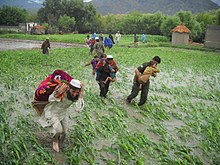
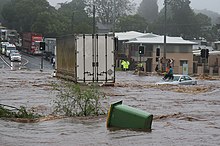
In the United States, the National Weather Service gives out the advice "Turn Around, Don't Drown" for floods; that is, it recommends that people get out of the area of a flood, rather than trying to cross it. At the most basic level, the best defense against floods is to seek higher ground for high-value uses while balancing the foreseeable risks with the benefits of occupying flood hazard zones.[56]: 22–23 Critical community-safety facilities, such as hospitals, emergency-operations centers, and police, fire, and rescue services, should be built in areas least at risk of flooding. Structures, such as bridges, that must unavoidably be in flood hazard areas should be designed to withstand flooding. Areas most at risk for flooding could be put to valuable uses that could be abandoned temporarily as people retreat to safer areas when a flood is imminent.
Planning for flood safety involves many aspects of analysis and engineering, including:
- observation of previous and present flood heights and inundated areas,
- statistical, hydrologic, and hydraulic model analyses,
- mapping inundated areas and flood heights for future flood scenarios,
- long-term land use planning and regulation,
- engineering design and construction of structures to control or withstand flooding,
- intermediate-term monitoring, forecasting, and emergency-response planning, and
- short-term monitoring, warning, and response operations.
Each topic presents distinct yet related questions with varying scope and scale in time, space, and the people involved. Attempts to understand and manage the mechanisms at work in floodplains have been made for at least six millennia.[57][page needed]
In the United States, the Association of State Floodplain Managers works to promote education, policies, and activities that mitigate current and future losses, costs, and human suffering caused by flooding and to protect the natural and beneficial functions of floodplains – all without causing adverse impacts.[58] A portfolio of best practice examples for disaster mitigation in the United States is available from the Federal Emergency Management Agency.[59]
Flood clean-up safety
Clean-up activities following floods often pose hazards to workers and volunteers involved in the effort. Potential dangers include electrical hazards, carbon monoxide exposure, musculoskeletal hazards, heat or cold stress, motor vehicle-related dangers, fire, drowning, and exposure to hazardous materials. Because flooded disaster sites are unstable, clean-up workers might encounter sharp jagged debris, biological hazards in the flood water, exposed electrical lines, blood or other body fluids, and animal and human remains. In planning for and reacting to flood disasters, managers provide workers with hard hats, goggles, heavy work gloves, life jackets, and watertight boots with steel toes and insoles.[60]
Flood predictions
Mathematical models and computer tools

A series of annual maximum flow rates in a stream reach can be analyzed statistically to estimate the 100-year flood and floods of other recurrence intervals there. Similar estimates from many sites in a hydrologically similar region can be related to measurable characteristics of each drainage basin to allow indirect estimation of flood recurrence intervals for stream reaches without sufficient data for direct analysis.
Physical process models of channel reaches are generally well understood and will calculate the depth and area of inundation for given channel conditions and a specified flow rate, such as for use in floodplain mapping and flood insurance. Conversely, given the observed inundation area of a recent flood and the channel conditions, a model can calculate the flow rate. Applied to various potential channel configurations and flow rates, a reach model can contribute to selecting an optimum design for a modified channel. Various reach models are available as of 2015, either 1D models (flood levels measured in the channel) or 2D models (variable flood depths measured across the extent of a floodplain). HEC-RAS,[61] the Hydraulic Engineering Center model, is among the most popular software, if only because it is available free of charge. Other models such as TUFLOW[62] combine 1D and 2D components to derive flood depths across both river channels and the entire floodplain.
Physical process models of complete drainage basins are even more complex. Although many processes are well understood at a point or for a small area, others are poorly understood at all scales, and process interactions under normal or extreme climatic conditions may be unknown. Basin models typically combine land-surface process components (to estimate how much rainfall or snowmelt reaches a channel) with a series of reach models. For example, a basin model can calculate the runoff hydrograph that might result from a 100-year storm, although the recurrence interval of a storm is rarely equal to that of the associated flood. Basin models are commonly used in flood forecasting and warning, as well as in analysis of the effects of land use change and climate change.
In the United States, an integrated approach to real-time hydrologic computer modelling uses observed data from the U.S. Geological Survey (USGS),[63] various cooperative observing networks,[64] various automated weather sensors, the NOAA National Operational Hydrologic Remote Sensing Center (NOHRSC),[65] various hydroelectric companies, etc. combined with quantitative precipitation forecasts (QPF) of expected rainfall and/or snow melt to generate daily or as-needed hydrologic forecasts.[66] The NWS also cooperates with Environment Canada on hydrologic forecasts that affect both the US and Canada, like in the area of the Saint Lawrence Seaway.
The Global Flood Monitoring System, "GFMS", a computer tool which maps flood conditions worldwide, is available online.[67] Users anywhere in the world can use GFMS to determine when floods may occur in their area. GFMS uses precipitation data from NASA's Earth observing satellites and the Global Precipitation Measurement satellite, "GPM". Rainfall data from GPM is combined with a land surface model that incorporates vegetation cover, soil type, and terrain to determine how much water is soaking into the ground, and how much water is flowing into streamflow.
Users can view statistics for rainfall, streamflow, water depth, and flooding every 3 hours, at each 12-kilometer gridpoint on a global map. Forecasts for these parameters are 5 days into the future. Users can zoom in to see inundation maps (areas estimated to be covered with water) in 1-kilometer resolution.[68]
Flood forecasts and warnings

Anticipating floods before they occur allows for precautions to be taken and people to be warned[69] so that they can be prepared in advance for flooding conditions. For example, farmers can remove animals from low-lying areas and utility services can put in place emergency provisions to re-route services if needed. Emergency services can also make provisions to have enough resources available ahead of time to respond to emergencies as they occur. People can evacuate areas to be flooded.
In order to make the most accurate flood forecasts for waterways, it is best to have a long time-series of historical data that relates stream flows to measured past rainfall events.[70] Coupling this historical information with real-time knowledge about volumetric capacity in catchment areas, such as spare capacity in reservoirs, ground-water levels, and the degree of saturation of area aquifers is also needed in order to make the most accurate flood forecasts.
Radar estimates of rainfall and general weather forecasting techniques are also important components of good flood forecasting. In areas where good quality data is available, the intensity and height of a flood can be predicted with fairly good accuracy and plenty of lead time. The output of a flood forecast is typically a maximum expected water level and the likely time of its arrival at key locations along a waterway,[66] and it also may allow for the computation of the likely statistical return period of a flood. In many developed countries, urban areas at risk of flooding are protected against a 100-year flood – that is a flood that has a probability of around 63% of occurring in any 100-year period of time.
According to the U.S. National Weather Service (NWS) Northeast River Forecast Center (RFC) in Taunton, Massachusetts, a rule of thumb for flood forecasting in urban areas is that it takes at least 1 inch (25 mm) of rainfall in around an hour's time in order to start significant ponding of water on impermeable surfaces. Many NWS RFCs routinely issue Flash Flood Guidance and Headwater Guidance, which indicate the general amount of rainfall that would need to fall in a short period of time in order to cause flash flooding or flooding on larger water basins.[71]
Flood risk assessment
Flood risks can be defined as the risk that floods pose to individuals, property and the natural landscape based on specific hazards and vulnerability. The extent of flood risks can impact the types of mitigation strategies required and implemented.[72]
A large amount of the world's population lives in close proximity to major coastlines,[8] while many major cities and agricultural areas are located near floodplains.[9] There is significant risk for increased coastal and fluvial flooding due to changing climatic conditions.[10]
Examples by country or region
- Worldwide: List of floods
- Africa: List of floods#Africa
- Asia: List of floods#Asia
- Europe: List of floods in Europe
- North Sea: Storm tides of the North Sea
- The Netherlands: Floods in the Netherlands, Flood control in the Netherlands
- Oceania: List of floods#Oceania
- Australia: Floods in Australia
- United States: Lists of floods in the United States
Society and culture
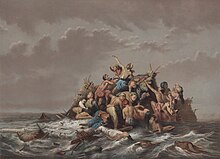
Myths and religion

A flood myth or a deluge myth is a myth in which a great flood, usually sent by a deity or deities, destroys civilization, often in an act of divine retribution. Parallels are often drawn between the flood waters of these myths and the primeval waters which appear in certain creation myths, as the flood waters are described as a measure for the cleansing of humanity, in preparation for rebirth. Most flood myths also contain a culture hero, who "represents the human craving for life".[73]
The flood-myth motif occurs in many cultures, including the manvantara-sandhya in Hinduism, Deucalion and Pyrrha in Greek mythology, the Genesis flood narrative, the Mesopotamian flood stories, and the Cheyenne flood story.Etymology
The word "flood" comes from the Old English flōd, a word common to Germanic languages (compare German Flut, Dutch vloed from the same root as is seen in flow, float; also compare with Latin fluctus, flumen), meaning "a flowing of water, tide, an overflowing of land by water, a deluge, Noah's Flood; mass of water, river, sea, wave".[74][75] The Old English word flōd comes from the Proto-Germanic floduz (Old Frisian flod, Old Norse floð, Middle Dutch vloet, Dutch vloed, German Flut, and Gothic flodus derives from floduz).[74]
See also
- Disaster response – Second phase of the disaster management cycle
- Diversion dam – Dam that diverts some flow of a river
- Emergency management – Dealing with all humanitarian aspects of emergencies
- Flood alert – Type of weather warning
- Mudflow – Form of mass wasting
References
- ^ MSN Encarta Dictionary, Flood Archived 2011-02-04 at the Wayback Machine, Retrieved on 2006-12-28, on 2009-10-31
- ^ Seneviratne, S.I., X. Zhang, M. Adnan, W. Badi, C. Dereczynski, A. Di Luca, S. Ghosh, I. Iskandar, J. Kossin, S. Lewis, F. Otto, I. Pinto, M. Satoh, S.M. Vicente-Serrano, M. Wehner, and B. Zhou, 2021: Chapter 11: Weather and Climate Extreme Events in a Changing Climate. In Climate Change 2021: The Physical Science Basis. Contribution of Working Group I to the Sixth Assessment Report of the Intergovernmental Panel on Climate Change [Masson-Delmotte, V., P. Zhai, A. Pirani, S.L. Connors, C. Péan, S. Berger, N. Caud, Y. Chen, L. Goldfarb, M.I. Gomis, M. Huang, K. Leitzell, E. Lonnoy, J.B.R. Matthews, T.K. Maycock, T. Waterfield, O. Yelekçi, R. Yu, and B. Zhou (eds.)]. Cambridge University Press, Cambridge, United Kingdom and New York, NY, USA, pp. 1513–1766, doi:10.1017/9781009157896.013.
- ^ Attribution of Extreme Weather Events in the Context of Climate Change (Report). Washington, DC: The National Academies Press. 2016. pp. 127–136. doi:10.17226/21852. ISBN 978-0-309-38094-2. Archived from the original on 2022-02-15. Retrieved 2020-02-22.
- ^ Hirabayashi, Yukiko; Mahendran, Roobavannan; Koirala, Sujan; Konoshima, Lisako; Yamazaki, Dai; Watanabe, Satoshi; Kim, Hyungjun; Kanae, Shinjiro (September 2013). "Global flood risk under climate change". Nature Climate Change. 3 (9): 816–821. Bibcode:2013NatCC...3..816H. doi:10.1038/nclimate1911. ISSN 1758-6798.
- ^ "How climate change is making record-breaking floods the new normal". United Nations Environmental Program. 3 March 2020.
- ^ Glossary of Meteorology (June 2000) Flood Archived 2007-08-24 at the Wayback Machine, Retrieved on 2009-01-09
- ^ "WHO | Flooding and communicable diseases fact sheet". WHO. Archived from the original on December 31, 2004. Retrieved 2021-03-28.
- ^ a b Neumann, Barbara; Vafeidis, Athanasios T.; Zimmermann, Juliane; Nicholls, Robert J. (2015-03-11). "Future Coastal Population Growth and Exposure to Sea-Level Rise and Coastal Flooding - A Global Assessment". PLOS ONE. 10 (3): e0118571. Bibcode:2015PLoSO..1018571N. doi:10.1371/journal.pone.0118571. ISSN 1932-6203. PMC 4367969. PMID 25760037.
- ^ a b c "Flood Risk Management in Canada | Research report". Geneva Association. 2020-11-24. Retrieved 2021-10-29.
- ^ a b Dieperink, C.; Hegger, D. L. T.; Bakker, M. H. N.; Kundzewicz, Z. W.; Green, C.; Driessen, P. P. J. (2016-10-01). "Recurrent Governance Challenges in the Implementation and Alignment of Flood Risk Management Strategies: a Review". Water Resources Management. 30 (13): 4467–4481. Bibcode:2016WatRM..30.4467D. doi:10.1007/s11269-016-1491-7. ISSN 1573-1650. S2CID 54676896.
- ^ Jones, Myrtle (2000). "Ground-water flooding in glacial terrain of southern Puget Sound, Washington". Fact Sheet. doi:10.3133/fs11100. Retrieved 2015-07-23.
- ^ "Red River of the North State Water Trail". Minnesota DNR. Accessed 8 September 2024
- ^ Hjalmarson, Hjalmar W. (December 1984). "Flash Flood in Tanque Verde Creek, Tucson, Arizona". Journal of Hydraulic Engineering. 110 (12): 1841–1852. doi:10.1061/(ASCE)0733-9429(1984)110:12(1841).
- ^ "Storm Surge Overview". noaa.gov. Retrieved 3 December 2015.
- ^ "Report: Flooded Future: Global vulnerability to sea level rise worse than previously understood". www.climatecentral.org. Archived from the original on 2020-03-30. Retrieved 2020-11-09.
- ^ "The Prevalence and Cost of Urban Flooding". Chicago, Illinois: Center for Neighborhood Technology. May 2013.
- ^ "Army Corps starts to blow up levee, flood 130,000 acres in Missouri". CNN. Retrieved May 23, 2018.
- ^ "Text Book of Fortification and Military Engineering: For Use at the Royal Military Academy, Woolwich, Volume 1". Google Books. H.M. Stationery Office. 1878. p. 50. Retrieved May 23, 2018.
- ^ Oosthoek, K.J. "The watery ally: military inundations in Dutch history (podcast)". Environmental History Resources. Retrieved May 23, 2018.
- ^ Tiegs, R. "Military Inundations during the Dutch Wars of Independence". Brief History of Military Inundations during the Dutch Wars of Independence. Archived from the original on May 24, 2018. Retrieved May 23, 2018.
- ^ Vandenbohed, Alexander (2016). "The hydrogeology of the military inundation at the 1914–1918 Yser front (Belgium)". Hydrogeology Journal. 24 (2): 521–534. Bibcode:2016HydJ...24..521V. doi:10.1007/s10040-015-1344-0. S2CID 131534974.
- ^ Tiegs, R. (13 April 2017). "The Past Comes Flooding Back: The War That Almost Sank Holland". NICHE. Network in Canadian History & Environment. Nouvelle initiative Canadienne en histoire de l'environnement. Retrieved May 23, 2018.
- ^ "Battle of the Yser". Encyclopædia Britannica.
- ^ Basic Biology (2016). "Wetlands".
- ^ "Flood Control", MSN Encarta, 2008 (see below: Further reading).
- ^ Babbitt, Harold E. & Doland, James J., Water Supply Engineering, McGraw-Hill Book Company, 1949
- ^ Simon, Andrew L., Basic Hydraulics, John Wiley & Sons, 1981, ISBN 0-471-07965-0
- ^ a b Simon, Andrew L., Practical Hydraulics, John Wiley & Sons, 1981, ISBN 0-471-05381-3
- ^ Urquhart, Leonard Church, Civil Engineering Handbook, McGraw-Hill Book Company, 1959
- ^ "What is high tide flooding?". National Oceanic and Atmospheric Administration's National Ocean Service. US Department of Commerce. Archived from the original on 16 October 2020. Retrieved 12 October 2020.
- ^ "2022 Sea Level Rise Technical Report". National Ocean Service, National Oceanic and Atmospheric Administration (NOAA). February 2022. Archived from the original on November 29, 2022.
- ^ a b c Douville, H., K. Raghavan, J. Renwick, R.P. Allan, P.A. Arias, M. Barlow, R. Cerezo-Mota, A. Cherchi, T.Y. Gan, J. Gergis, D. Jiang, A. Khan, W. Pokam Mba, D. Rosenfeld, J. Tierney, and O. Zolina, 2021: Chapter 8: Water Cycle Changes. In Climate Change 2021: The Physical Science Basis. Contribution of Working Group I to the Sixth Assessment Report of the Intergovernmental Panel on Climate Change [Masson-Delmotte, V., P. Zhai, A. Pirani, S.L. Connors, C. Péan, S. Berger, N. Caud, Y. Chen, L. Goldfarb, M.I. Gomis, M. Huang, K. Leitzell, E. Lonnoy, J.B.R. Matthews, T.K. Maycock, T. Waterfield, O. Yelekçi, R. Yu, and B. Zhou (eds.)]. Cambridge University Press, Cambridge, United Kingdom and New York, NY, US, pp. 1055–1210, doi:10.1017/9781009157896.010
- ^ Abbett, Robert W., American Civil Engineering Practice, John Wiley & Sons, 1956
- ^ United States Department of the Interior, Bureau of Reclamation, Design of Small Dams, United States Government Printing Office, 1973
- ^ Brown, Richard; Chanson, Hubert; McIntosh, Dave; Madhani, Jay (2011). Turbulent Velocity and Suspended Sediment Concentration Measurements in an Urban Environment of the Brisbane River Flood Plain at Gardens Point on 12–13 January 2011. Hydraulic Model Report No. CH83/11. p. 120. ISBN 978-1-74272-027-2.
- ^ Chanson, H.; Brown, R.; McIntosh, D. (26 June 2014). "Human body stability in floodwaters: The 2011 flood in Brisbane CBD". In L. Toombes (ed.). Hydraulic structures and society - Engineering challenges and extremes (PDF). Brisbane, Australia: Proceedings of the 5th IAHR International Symposium on Hydraulic Structures (ISHS2014). pp. 1–9. doi:10.14264/uql.2014.48. ISBN 978-1-74272-115-6.
- ^ a b c SCHANZE, JOCHEN (2006). "Flood Risk Management – A Basic Framework". In Schanze, Jochen; Zeman, Evzen; Marsalek, Jiri (eds.). Flood Risk Management: Hazards, Vulnerability and Mitigation Measures. NATO Science Series. Vol. 67. Dordrecht: Springer Netherlands. pp. 1–20. doi:10.1007/978-1-4020-4598-1_1. ISBN 978-1-4020-4598-1.
- ^ a b Morrison, A.; Westbrook, C.J.; Noble, B.F. (2018). "A review of the flood risk management governance and resilience literature". Journal of Flood Risk Management. 11 (3): 291–304. Bibcode:2018JFRM...11..291M. doi:10.1111/jfr3.12315. S2CID 134055424.
- ^ Society, National Geographic (2011-11-07). "flood". National Geographic Society. Retrieved 2022-03-10.[permanent dead link]
- ^ Stephen Bratkovich, Lisa Burban, et al., "Flooding and its Effects on Trees" Archived 2016-06-14 at the Wayback Machine, USDA Forest Service, Northeastern Area State and Private Forestry, St. Paul, MN, September 1993
- ^ Center for Neighborhood Technology, Chicago IL "The Prevalence and Cost of Urban Flooding", May 2013
- ^ "Protecting Your Businesses", last updated March 2013
- ^ "National Flood Insurance Program". FloodSmart.gov. Archived from the original on 2016-12-22. Retrieved 2015-07-06.
- ^ a b c d e f g Alderman, Katarzyna; Turner, Lyle R.; Tong, Shilu (June 2012). "Floods and human health: A systematic review" (PDF). Environment International. 47: 37–47. Bibcode:2012EnInt..47...37A. doi:10.1016/j.envint.2012.06.003. PMID 22750033.
- ^ Ahadzie, Divine Kwaku; Mensah, Henry; Simpeh, Eric (2022). "Impact of floods, recovery, and repairs of residential structures in Ghana: insights from homeowners". GeoJournal. 87 (4): 3133–3148. Bibcode:2022GeoJo..87.3133A. doi:10.1007/s10708-021-10425-2. ISSN 0343-2521. S2CID 234825689.
- ^ Indoor Air Quality (IAQ) Scientific Findings Resource Bank (IAQ-SFRB), "Health Risks or Dampness or Mold in Houses" Archived 2013-10-04 at the Wayback Machine
- ^ Demain, Jeffrey G. (24 March 2018). "Climate Change and the Impact on Respiratory and Allergic Disease: 2018". Current Allergy and Asthma Reports. 18 (4): 22. doi:10.1007/s11882-018-0777-7. ISSN 1534-6315. PMID 29574605. S2CID 4440737.
- ^ Worst Natural Disasters In History Archived 2008-04-21 at the Wayback Machine (2012-06-07), Retrieved on 2012-06-12
- ^ WMO/GWP Associated Programme on Flood Management, "Environmental Aspects of Integrated Flood Management" Archived 2015-07-13 at the Wayback Machine, 2007
- ^ Extension of the Flood Pulse Concept[permanent dead link], Retrieved on 2012-06-12
- ^ Birdlife soars above Botswana's floodplains Archived 2011-02-09 at the Wayback Machine (2010-10-15), Retrieved on 2012-06-12
- ^ Raadgever, G. T. (Tom); Booister, Nikéh; Steenstra, Martijn K. (2018), Raadgever, Tom; Hegger, Dries (eds.), "Flood Risk Management Strategies", Flood Risk Management Strategies and Governance, Cham: Springer International Publishing, pp. 93–100, doi:10.1007/978-3-319-67699-9_8, ISBN 978-3-319-67699-9, retrieved 2021-11-03
- ^ "Strengthening climate resilience through better flood management". ReliefWeb. 30 July 2021. Retrieved 2021-11-04.
- ^ Paoletti, Michele; Pellegrini, Marco; Belli, Alberto; Pierleoni, Paola; Sini, Francesca; Pezzotta, Nicola; Palma, Lorenzo (January 2023). "Discharge Monitoring in Open-Channels: An Operational Rating Curve Management Tool". Sensors. 23 (4). MDPI (published 10 February 2023): 2035. Bibcode:2023Senso..23.2035P. doi:10.3390/s23042035. ISSN 1424-8220. PMC 9964178. PMID 36850632.
- ^ Henry Petroski (2006). Levees and Other Raised Ground. Vol. 94. American Scientist. pp. 7–11.
- ^ Eychaner, J.H. (2015) Lessons from a 500-year record of flood elevations, Association of State Floodplain Managers, Technical Report 7 Archived 2015-06-27 at the Wayback Machine, Accessed 2015-06-27
- ^ Dyhouse, G., "Flood modelling Using HEC-RAS (First Edition)", Haestad Press, Waterbury (USA) 2003-26-41
- ^ "Association of State Floodplain Managers". Retrieved 2015-07-13.
- ^ "Best Practices Portfolio". Federal Emergency Management Agency. Retrieved 2015-07-06.
- ^ "Storm/Flood and Hurricane/Typhoon Response". Emergency Response Resources. National Institute for Occupational Safety and Health. Archived from the original on Feb 29, 2024.
- ^ "Hydrologic Engineering Center Home Page". hec.usace.army.mil. Davis, CA: United States Army Corps of Engineers. Archived from the original on 2013-03-08.
- ^ "TUFLOW | Flood, Urban Stormwater, Coastal and Water Quailty computer modelling software". tuflow.com. Archived from the original on 2008-06-27.
- ^ "WaterWatch". USGS. Retrieved 4 February 2013.
- ^ "Community Collaborative Rain, Hail and Snow Network". Retrieved 4 February 2013.
- ^ "NOHRSC". 2 May 2012. Archived from the original on 19 April 2021. Retrieved 4 February 2013.
- ^ a b Connelly, Brian A; Braatz, Dean T; Halquist, John B; Deweese, Michael M; Larson, Lee; Ingram, John J (1999). "Advanced Hydrologic Prediction System". Journal of Geophysical Research. 104 (D16): 19, 655. Bibcode:1999JGR...10419655C. doi:10.1029/1999JD900051. Retrieved 4 February 2013.
- ^ "Global Flood Monitoring". flood.umd.edu. Retrieved 2024-01-15.
- ^ "Predicting Floods". science.nasa.gov. Retrieved 2015-07-22.
- ^ "Flood Warnings". Environment Agency. 2013-04-30. Retrieved 2013-06-17.
- ^ "Australia rainfall and river conditions". Bom.gov.au. Retrieved 2013-06-17.
- ^ "FFG". Archived from the original on 4 March 2013. Retrieved 29 January 2013.
- ^ Schumann, Andreas H., ed. (2011). Flood Risk Assessment and Management. doi:10.1007/978-90-481-9917-4. ISBN 978-90-481-9916-7.
- ^ Leeming, David (2004). Flood | The Oxford Companion to World Mythology. Oxford University Press. ISBN 9780195156690. Retrieved 17 September 2010.
- ^ a b "Etymology of flood". Online Etymology Dictionary. Harper Douglas. Retrieved February 21, 2022.
- ^ "FLOOD English Definition and Meaning". Lexico Dictionaries | English. Archived from the original on July 2, 2020. Retrieved 2022-02-21.


